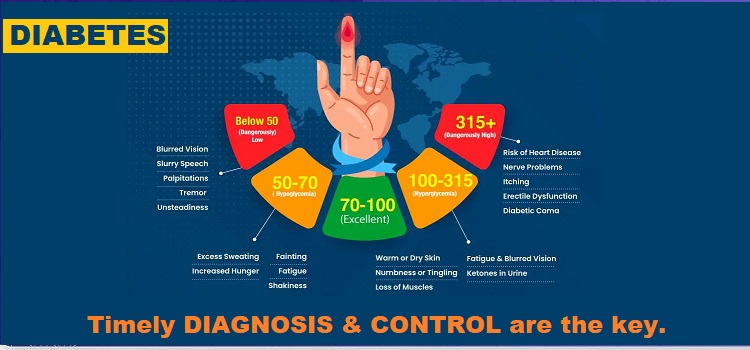Diabetes
- 2022-11-14
Diabetes,
is a long-term metabolic disorder that occurs when blood glucose levels remain
above normal limits. It occurs when the pancreas – which produces the hormone
insulin – either fails to produce (any or enough) insulin or fails to
effectively use the insulin to keep the blood glucose in control.
Globally,
an estimated 463 million (2019) people have diabetes.
Usually
seen in Both men and women
Type
1 diabetes: Children below 15 years of age
Type
2 diabetes: Adults between 20 to 80 years of age
SYMPTOMS
OF DIABETES
Irrespective
of the types, some of the common symptoms of diabetes include:
Frequent
urination
Excessive
thirst
Sudden
loss of weight
Increased
hunger
Blurry
eyesight
Bedwetting
Lack
of energy/fatigue
Delayed
healing of cuts and other injuries
Dry
skin
Fungal
infections
If
diagnosed with diabetes (fasting >125 mg/dL and/or post meal >200 mg/dL),
you may need to undergo several health tests periodically. The common lab tests
include blood tests and urine tests.
Diabetes
can be treated with lifestyle modifications, oral medications, and a few
injectables. Uncontrolled diabetes over the long term, can cause damage to the
eyes, nerves, kidneys, legs, and heart.
BLOOD
TESTS
Random
Blood Sugar
The
random blood glucose test is done to measure the levels of glucose circulating
in the blood. This test is done to diagnose diabetes. You can take this test at
any time of the day as it does not need you to fast unlike other tests for
diabetes. However, other tests are required to confirm the diagnosis. The test
is done as a part of routine preventive health check-up or if you have symptoms
of high blood glucose/hyperglycemia.
According
to the American Diabetes Association guidelines for diabetes testing, the
values for random blood glucose test are as follows:
Normal:
Less than 140 mg/dl
Prediabetes:
Between 140 and 200 mg/dl
Diabetes:
Greater than or equal to 200 mg/dl
Pregnant
women: Greater than or equal to 200 mg/dl
Fasting
Blood Sugar
The
fasting blood glucose test is one of the most common tests prescribed for
diabetes. It is a blood test that measures the levels of glucose in the blood
in the fasting state (empty stomach). Ideally, it is advised to not eat or
drink anything (except water) for 8-12 hours before the test. It is the
simplest as well as the fastest test to diagnose and monitor diabetes.
According
to the American Diabetes Association guidelines for diabetes testing, the
values for FBS are as follows:
Normal:
Less than 100 mg/dl
Prediabetes:
Between 100 mg/dl to 125 mg/dl
Diabetes:
Greater than or equal to126 mg/dl
Pregnant
women: Between 90-140 mg/dl
Postprandial
Blood Sugar (PP)
It
is performed to measure glucose levels in the blood after a period of 2 hours
from the start of the last meal. It is usually recommended to screen for
prediabetes and diabetes types 1 and 2. It is also used to monitor treatment
efficacy in patients undergoing treatment for diabetes. The test is usually
recommended when the blood glucose level falls between 140 and 200 mg/dl.
According
to the American Diabetes Association guidelines for diabetes testing, the
values for PP are as follows:
Normal:
Less than 140 mg/dl
Impaired
glucose tolerance (prediabetes): Between 140 and 200 mg/dl
Diabetes:
Greater than or equal to 200 mg/dl
Hemoglobin
A1c (HbA1c)
It
is a blood test that measures a person’s average blood glucose level over the
past 2 to 3 months. It is ideally used to check how well your diabetes is
managed with medication. However, if your fasting and postprandial levels are
high, then HbA1c is advised to confirm the diagnosis.
According
to the American Diabetes Association guidelines for diabetes testing, the
values for HbA1c are as follows:
Normal:
Less than 5.7%
Prediabetes:
Between 5.7% to 6.4%
Diabetes:
Greater than or equal to 6.5%
Pregnant
women: Between 6% to 6.5%
Glucose
Tolerance Test (GTT)
The
test is used to check the blood glucose levels before and 2 hours after you
have a sweet drink (which in most cases is a glucose solution). The test tells
your doctor how well your body processes the glucose (sugar) which in turn aids
in the diagnosis of diabetes.
According
to the American Diabetes Association guidelines for diabetes testing, the
values for GTT are as follows:
Normal:
Less than 140 mg/dl
Prediabetes:
Between 140 mg/dl to 199 mg/dl
Diabetes:
Greater than or equal to 200 mg/dl
Pregnant
women: Greater than or equal to 200 mg/dl
OTHER
TESTS
If
diagnosed with diabetes, you may need to undergo several health tests
periodically. These include:
Blood
pressure
According
to the American Heart Association, your blood pressure must be less than 120/80
mmHg. This is because patients who keep their blood pressure under control are
less likely to suffer from diabetes-related complications such as heart
attacks, blindness, or kidney damage.
Get
your blood pressure checked at every doctor’s visit or twice every month. You
should also self-monitor your blood pressure and maintain a blood pressure
diary if you have high blood pressure coexisting with diabetes.
Eye
examination
You
should visit an ophthalmologist (eye specialist) once every year for a detailed
eye examination. The doctor would check for any damage to the nerve tissues on
the back of the eye (retina). Diabetes may lead to diabetic retinopathy and
cataract.
Foot
examination
You
must visit your doctor for a foot examination at least once every year to get
your pulse and reflexes checked in your feet. You may also be examined for any
unhealed cut, infections, sores or loss of feeling anywhere in your feet. Here
are a few footcare tips for diabetes.
Lipid
profile test
Cholesterol
is a waxy substance present in your blood as HDL (good cholesterol) and LDL
(bad cholesterol). With diabetes, the LDL levels and triglycerides tend to
increase while the HDL levels decrease, increasing the risk of heart disease
and stroke.
Kidney
function tests
You
should get a yearly check for your kidneys through kidney function tests (blood
tests) and a urine test. This is because, in diabetics, the blood vessels in
the kidneys get injured and your kidneys cannot clean your blood properly. As a
result, your body will retain more water, salt and protein than it should,
which in turn can affect your kidney’s health.
Liver
function tests (LFT)
It
should be done once annually as it helps determine the health of your liver by
measuring the levels of proteins, liver enzymes, or bilirubin in your blood.
Type 2 diabetes is associated with impairment in liver function by increasing
the level of the liver enzymes and the risk of fatty liver disease, liver
cirrhosis and liver failure.
Vitamin
B12 test
In
case you are taking metformin for a long time, then you must get your Vitamin
B12 levels checked as the use of metformin may cause Vitamin B12 deficiency.
Periodic measurement of Vitamin B12 levels should be considered especially if
you have anemia or peripheral neuropathy.
Dental checkup
Get yourself examined every 6 months by a dentist for your gums, teeth and regular cleaning. This is because high levels of glucose in blood can lead to pain, burning and redness in the mouth and increase the risk of various oral problems such as gingivitis (inflamed gums), periodontitis (gum disease), oral thrush, and dry mouth.
TYPE
OF DIABETES
Type
1 diabetes
It
is known to be caused due to an autoimmune reaction in which the immune system
attacks the insulin-producing beta cells of the pancreas and leads to
destruction. As a result, there is very little or no insulin production, which
affects the blood glucose control.
Although
the exact cause of this process is not yet fully understood, it is believed
that genes as well as environmental factors such as viral infection, toxins or
dietary factors play a role. It occurs most commonly in children and young people.
Type
2 diabetes
It
is caused because of the inability of the body to respond properly to insulin,
leading to insulin resistance. This causes the hormone insulin to be
ineffective, which in turn, causes the body to produce more insulin. As a
result, the pancreas fails to keep up the body’s demand for more insulin. This
gradually causes inadequate production of insulin leading to high blood
glucose.
Most
cases of type 2 diabetes go through a stage known as prediabetes, in which the
cells do not respond normally to insulin.
Although
type 2 diabetes is common in adults, it is also seen in older children due to
childhood obesity becoming more common. The list of factors that increase the
risk of type 2 diabetes include:
· Being
overweight or obese
· Being
a smoker
· Family
history of diabetes
· Family
history of high cholesterol, hypertension, or cardiovascular disease
· Having
a sedentary lifestyle
· Suffering
from polycystic ovarian syndrome (PCOS)
· Suffering
from prediabetes
· Being
pregnant
· Recurrent
wounds/ulcers, which fail to heal
· Stress
· History
of diabetes in pregnancy
· History
of impaired glucose tolerance
Prediabetes
As
the name suggests, prediabetes is a condition where the blood glucose levels
are higher than normal but not high enough to be classified as diabetes. In
simple terms, it is a stage that, if left ignored, can develop into type 2
diabetes and diabetes-related complications. This is the reason why it is also
known as ‘non-diabetic hyperglycemia’ or ‘intermediate hyperglycemia.’ There
are no clear symptoms of prediabetes, so you may have it and not know it.
However, early treatment with lifestyle modifications can help to keep your
blood glucose levels within the normal range.
Gestational
diabetes
Gestational
diabetes mellitus (GDM), defined as diabetes diagnosed during pregnancy,
affects a significant proportion of pregnant women worldwide. Women usually
develop gestational diabetes between the second or third trimester of
pregnancy. The risk of developing this condition during your future pregnancies
may also be higher. It also increases the risk of brain and spinal cord
anomalies, obesity, and glucose intolerance (diabetes) in the child. Due to the
major repercussions in mother and baby, it is important for every pregnant
woman to be aware of GDM.
According
to the IDF, women with prior GDM are at a 7.4-fold risk of type 2 diabetes
compared to women with normal blood glucose levels during pregnancy. This risk
is higher 3 to 6 years post-delivery. Certain factors that put you at high risk
of gestational diabetes include:
· BMI
(Body Mass Index) that exceeds 30
· Excessive
weight gain during pregnancy
· Family
history of diabetes
· History
of giving birth to a baby weighing 4.5kg or more
· Expecting
more than one baby (twins/triplets)
· Family
history of hypertension
· History
of miscarriages or stillbirth
· History
of conditions related to insulin resistance or polycystic ovarian syndrome
(PCOS)
· History
of habitual smoking
· Giving
birth to a child with congenital abnormality
Monogenic
diabetes
As
the name implies, monogenic diabetes results from a single gene rather than the
contributions of multiple genes and environmental factors as seen in type 1 and
type 2 diabetes. It is much less common and represents 1.5–2% of all cases. It
is often misdiagnosed as either type 1 or type 2 diabetes. These monogenic
forms present a broad spectrum from neonatal diabetes mellitus (or ‘monogenic
diabetes of infancy’), maturity onset diabetes of the young (MODY) and rare
diabetes associated syndromic diseases.
Note:
Impaired glucose tolerance (IGT) and impaired fasting glycaemia (IFG) are
intermediate conditions in the transition between normality and diabetes.
People with IGT or IFG are at a high risk of progressing to type 2 diabetes,
although this is not inevitable.
PREVENTION
OF DIABETES
With
simple lifestyle changes such as diet control, staying active, keeping a tab on
your weight, and staying away from vices, you can lower your risk of type 2
diabetes. Here are a few tips to get started.
Make
healthy food choices
Taking
care of your diet is one of the most essential components to manage and prevent
diabetes.
Switch
to oils with high volume of monounsaturated fats & polyunsaturated fats
like olive oil, canola oil, soybean oil or rice bran oil. Limit intake to one
tablespoon a day.
Restrict
intake of foods with high glycemic index like white breads, white rice, fatty
foods, and soda.
Consume
foods with low glycemic index like multigrain flour, whole grains, daals, most
fruits, non-starchy vegetables, and carrots.
Limit
consumption of fast food such as chips, processed foods, etc.
Watch
your weight
Losing
weight can help to regulate blood sugar levels. If you have type 2 diabetes,
losing just 4-6 kgs can lower your glucose levels.
The
way fat is distributed in the body can also impact diabetes risk and
management. People who have abdominal adiposity (fat around belly) are more
prone to type 2 diabetes than those with fat mostly in the thighs, hips, and
buttocks.
Exercise
regularly
Regular
exercise is a good way to keep your body healthy and prevent diabetes.
Exercises
are designed to help people with diabetes avoid problems which can result from
unwise exercise choices. Aerobic activity is one of the effective exercise
options to control diabetes. When done at moderate intensity it raises your
heart rate and makes you sweat thereby helping you to maintain an optimum blood
glucose level.
Some
of the common forms of aerobic exercises are: Brisk (fast-paced) walking, Light
jogging, Bike riding, Playing tennis or badminton, Swimming/ water aerobics, Gymming
Warm
up for 5 minutes before starting to exercise and cool down for 5 minutes after
exercise.
Be
more active throughout the day. This includes parking your car further from
your house/office, opting for stairs instead of the elevator or walking instead
of sitting while talking on the phone.
Manage
stress better
Stress
can make blood sugar levels harder to control. Avoid unnecessary stress by
indulging in activities that can help you relieve stress such as reading,
traveling, sports, and other hobbies.
You
can also try relaxation techniques such as meditation and yoga to alleviate
anxiety and stress. You may join a yoga club or take out 10-15 minutes every
day to practice meditation.
Finding
it hard to deal with stress? Try our wide-range of stress management products.
Quit
smoking
Smoking
has been found to directly increase the risk of several diabetes complications
such as cardiovascular diseases, stroke, eye diseases, nerve damage, and kidney
damage. It has also been found to reduce blood flow to the feet and other body
extremities. This can lead to foot problems and slow down the healing of
injuries. Irregular blood flow can lead to infections and unwanted mouth
ulcers, which puts you at risk of oral health problems.
Go
for regular health check-ups
As
most of the symptoms of diabetes are not detected until late in its course, it
is wise to get a preventive health checkup to know about diabetes. Get HbA1c
level every three months along with a doctor visit every six months to a year
if you have any risk factors of diabetes like hypertension, obesity, or heart
disease.
Recording
and maintaining charts of your blood glucose levels daily helps you to know how
well your treatment is working. Do not skip your medicines or stop taking your
medicines even if your diabetes is in control.
Specialist to Visit
If
you have been experiencing symptoms such as tingling sensation or numbness of
the limbs, feeling excessively hungry or thirsty, or unexplained weight loss,
then it is wise to consult following specialists:
Endocrinologist
Diabetologist
If
you are already diagnosed with diabetes, then getting a regular health check-up
is a must. This is because, chronic or uncontrolled diabetes can impact other
major organs of the body such as the eyes, legs, nerves, kidneys, and gums. So,
if you suffer from any complications due to diabetes, then getting in touch
with the respective specialist can help you to manage and prevent these
problems. Some of the common specialists who can help are:
Nephrologist
Neurologist
Dentist
Ophthalmologist
Dietician
DIET
IN DIABETES
Whether
you are trying to prevent or control diabetes, your nutritional needs are
virtually the same as everyone else, so no special foods are necessary.
However, certain modifications in terms of quantity and type of food might be
required.
Eat
more
Healthy
fats from nuts, olive oil, fish oils, flax seeds, or avocados
Fruits
and vegetables—ideally fresh, the more colorful the better; whole fruit rather
than juices
High-fiber
cereals and breads made from whole grains
Fish
and shellfish, organic chicken, or turkey
High-quality
protein such as eggs, beans, low-fat dairy, and unsweetened yogurt
Eat
less
Trans
fats from partially hydrogenated or deep-fried foods
Packaged
and fast foods, especially those high in sugar, baked goods, sweets, chips,
desserts
White
bread, sugary cereals, refined pastas, or rice
Processed
meat and red meat
Low-fat
products that have replaced fat with added sugar, such as fat-free yogurt
Choose
high-fiber, slow-release carbs
Carbohydrates
have a big impact on your blood sugar levels—more so than fats and proteins—so
you need to be smart about what types of carbs you eat. Limit refined
carbohydrates like white bread, pasta, and rice, as well as soda, candy,
packaged meals, and snack foods. Focus on high-fiber complex carbohydrates—also
known as slow-release carbs. They are digested more slowly, thus preventing
your body from producing too much insulin.
Fruits
There
is mixed perception about intake of fruits for diabetes. Some people believe
that diabetics should completely cut down fruits from their diet while some
think that one can include as much fruits as they want in their diet as it does
not have any impact on blood glucose level. However, neither is true. It is
best to include fruits as an integral part of your daily meal plan while
keeping a tab on the carbohydrate content. Here is a quick guide to help you
out with your daily needs of fruits:
Whole
fruits:1 small apple, chickoo, orange, guava, pear
Cut
fruits: Half banana,1 slice mango,1 cup papaya, 3/4th cup muskmelon,1 ¼ cup
watermelon
Medically Reviewed by
Dr. Ramendra Kumar Raman,
PhD, Clinical Research
References
IDF DIABETES ATLAS. Ninth edition 2019. International
Diabetes Federation (IDF).
Understanding A1c Diagnosis. American Diabetes
Association (ADA).
Varma PP. Prevalence of chronic kidney disease in India -
Where are we heading? Indian J Nephrol. 2015;25(3):133-135.
Kharroubi AT, Darwish HM. Diabetes mellitus: The epidemic
of the century. World J Diabetes. 2015;6(6):850-867.
Maiorino MI, Bellastella G, Esposito K. Diabetes and
sexual dysfunction: current perspectives. Diabetes Metab Syndr Obes.
2014;7:95-105
Pandey A, Tripathi P, Pandey R, Srivatava R, Goswami S.
Alternative therapies useful in the management of diabetes: A systematic
review. J Pharm Bioallied Sci. 2011;3(4):504-512.
Prediabetes - Your Chance to Prevent Type 2 Diabetes.
Centers For Disease Control and Prevention (CDC). Last reviewed June 2020.
Sapra A, Bhandari P. Diabetes Mellitus. [Updated 2021 Jun
8]. In: StatPearls [Internet]. Treasure Island (FL): StatPearls Publishing;
2021 Jan.
Diabetes, Gum Disease, & Other Dental
Problems. National Institute of Diabetes and Digestive and Kidney Diseases
(NIDDK). Last reviewed by Sep, 2014.



























Leave Comment